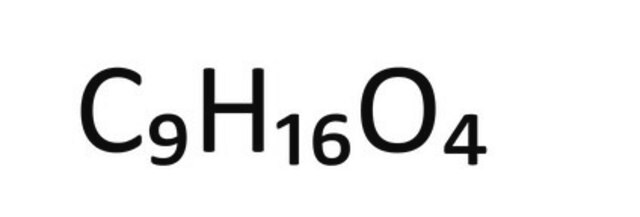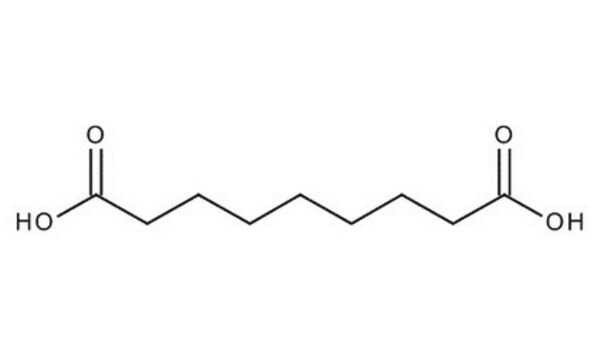A96150
Azelaic acid
technical grade, 80%
Synonyme(s) :
1,7-Heptanedicarboxylic acid, Anchoic acid, Nonanedioic acid
About This Item
Produits recommandés
Qualité
technical grade
Densité de vapeur
6.5 (vs air)
Pression de vapeur
<1 mmHg ( 20 °C)
Pureté
80%
Forme
powder
Point d'ébullition
286 °C/100 mmHg (lit.)
Pf
109-111 °C (lit.)
Chaîne SMILES
OC(=O)CCCCCCCC(O)=O
InChI
1S/C9H16O4/c10-8(11)6-4-2-1-3-5-7-9(12)13/h1-7H2,(H,10,11)(H,12,13)
Clé InChI
BDJRBEYXGGNYIS-UHFFFAOYSA-N
Vous recherchez des produits similaires ? Visite Guide de comparaison des produits
Description générale
Application
- Synthesis of pH-responsive metallo-hydrogels as potential dye-adsorbing agents, and vitamin B12 carriers.
- Synthesis of fluorescent uranyl (UO22+) coordination polymers.
- Synthesis of various metal-organic frameworks (MOFs) and supramolecular macrocyclic adducts.
- Conversion of hydrophobic up-converting rare-earth nanophosphors (UCNPs) into water-soluble, carboxylic acid-functionalized analogs to facilitate conjugation with biomolecules such as streptavidin.
Mention d'avertissement
Warning
Mentions de danger
Conseils de prudence
Classification des risques
Eye Irrit. 2 - Skin Irrit. 2
Code de la classe de stockage
11 - Combustible Solids
Classe de danger pour l'eau (WGK)
WGK 1
Point d'éclair (°F)
410.0 °F - closed cup
Point d'éclair (°C)
210 °C - closed cup
Équipement de protection individuelle
Eyeshields, Gloves, type N95 (US)
Certificats d'analyse (COA)
Recherchez un Certificats d'analyse (COA) en saisissant le numéro de lot du produit. Les numéros de lot figurent sur l'étiquette du produit après les mots "Lot" ou "Batch".
Déjà en possession de ce produit ?
Retrouvez la documentation relative aux produits que vous avez récemment achetés dans la Bibliothèque de documents.
Les clients ont également consulté
Notre équipe de scientifiques dispose d'une expérience dans tous les secteurs de la recherche, notamment en sciences de la vie, science des matériaux, synthèse chimique, chromatographie, analyse et dans de nombreux autres domaines..
Contacter notre Service technique









